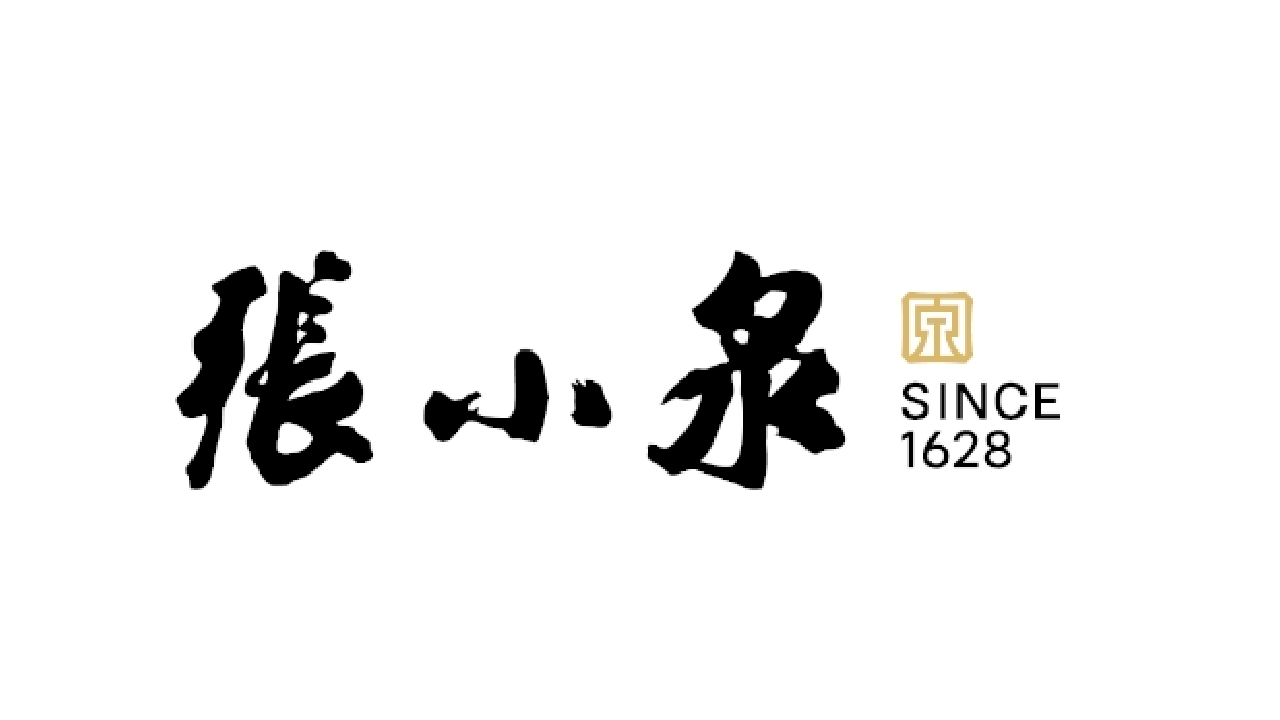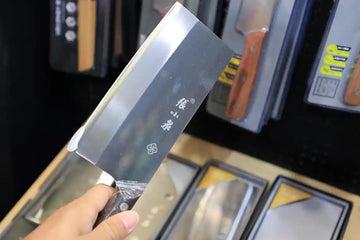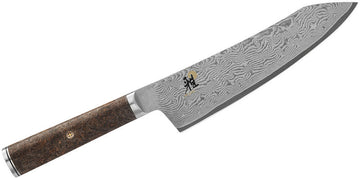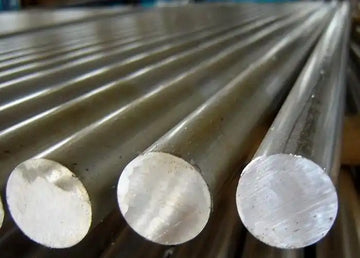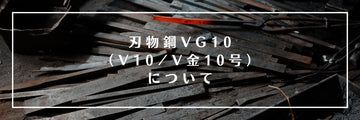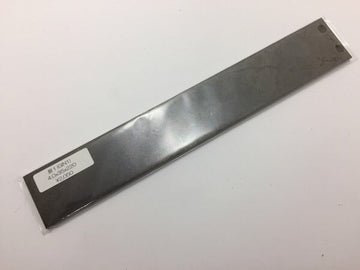In the world of kitchen knives, 4Cr13(40Cr13) steel is like that reliable economy car - not flashy or high-performance, but dependable enough to get you where you need to go without breaking the bank. This Chinese stainless steel has found its place in many commercial kitchens and first-time knife owners' blocks by offering decent performance with excellent corrosion resistance at a very accessible price point. With about 0.4% carbon and 13% chromium, it focuses more on resisting rust than holding an edge, making it forgiving for those new to knife care.
What 4Cr13 steel is made of
The name "4Cr13" (40Cr13) tells us the key ingredients in this steel recipe:
- The "4" indicates about 0.4% carbon content, enough for basic hardness but less than premium knife steels
- "Cr13" means it contains approximately 13% chromium, providing very good rust resistance
- It also contains small amounts of manganese and silicon to improve the steel's properties
Unlike more expensive steels, 4Cr13 doesn't contain specialty elements like molybdenum or vanadium. It's a simple, straightforward formulation designed to be economical while maintaining essential stainless properties. Think of it as a basic recipe that gets the job done without fancy ingredients.
How 4Cr13 performs in the kitchen knives
Edge retention and cutting ability
With moderate carbon content, 4Cr13 achieves a hardness of 48-53 HRC, which is softer than most higher-end knife steels. This means it won't hold its edge as long as premium options. You'll notice it dulling faster, especially when working with tougher ingredients or doing high-volume prep work.

However, this steel performs adequately for casual home cooking, maintaining a functional edge through several meal preparations before needing attention. It can handle basic vegetable cutting, meat slicing, and general food prep with reasonable effectiveness. Think of it as having "good enough" cutting performance for everyday tasks, rather than exceptional edge retention.
Corrosion resistance and durability
Where 4Cr13 truly shines is in its resistance to rust and staining. The 13% chromium content creates a protective barrier that stands up well to moisture, acidic foods, and even dishwasher cycles. This makes it particularly user-friendly for beginners or in busy kitchens where immediate knife care might be overlooked.

This strong corrosion resistance means you can be a bit more relaxed about maintenance. While it's still best to hand wash and dry promptly, this steel forgives the occasional neglect that would quickly rust carbon steel or even some other stainless options. 4Cr13 knives are unlikely to develop rust spots even after exposure to acidic ingredients or slightly damp storage.
The steel also offers reasonable toughness for a budget option. It's less brittle than some harder steels, so while it may dull more quickly, it's less likely to chip or crack under moderate stress. This practical durability makes it suitable for environments where knives might see rougher handling.
4Cr13 Applications in kitchen knives
Everyday budget options
4Cr13 excels as the steel of choice for entry-level kitchen knives. Its balanced properties make it suitable for basic chef's knives, utility knives, and general-purpose kitchen sets. The corrosion resistance handles everyday kitchen conditions, while its adequate performance meets the needs of casual cooks and beginners.
Many manufacturers use 4Cr13 for their budget lines, offering consumers their first step up from generic unmarked stainless steel knives. These typically retail in the $15-30 range, making quality kitchen tools accessible to almost everyone. This affordability has helped many people start their journey with better cutlery without significant investment.
Zhang Xiaoquan offers several reliable kitchen knives made from 4Cr13 steel, showcasing how proper manufacturing can maximize this economical material's strengths for everyday cooking needs.
Standout examples from Zhang Xiaoquan
Some notable Zhang Xiaoquan models featuring 4Cr13 steel include:
-
4Cr13(40Cr13) Steel 305mm Chinese Meat Cleaver: provides professional food preparation capabilities for diverse kitchen tasks. Designed with precision engineering and ergonomic handles to efficiently process various ingredients and meats.
-
310mm 4Cr13(40Cr13) Chinese Meat Cleaver: features a 300g high-carbon steel design that maintains consistent performance through 200+ uses. This versatile tool excels at precise vegetable preparation while efficiently handling frozen ingredients.
-
4Cr13(40Cr13) Steel 305mm Chopper Cleaver: Designed with a wide blade and balanced weight to support smooth, precise preparation. Perfect for professional Chinese cooking and home kitchen use.
-
315mm 4Cr13(40Cr13) Multi-Purpose Knife: One-piece design that won't break at the handle. Special tip shape cuts all foods easily with a non-stick surface. Keeps food flavor intact and cuts cleanly through vegetables, meat, and fruit.
-
4Cr13(40Cr13) Steel 305mm Bone Chopper: provides efficient food preparation capabilities in professional kitchen environments. Balanced weight and ergonomic design support precise ingredient preparation tasks. Perfect for professional kitchens and home cooks working with various ingredients.
-
275mm 4Cr13(40Cr13) Steel Bone Chopper: Features a quality high-carbon steel design for efficient food preparation. This professional 320g tool provides reliable performance for restaurant and professional kitchen tasks.
-
302mm 4Cr13(40Cr13) Steel Heavy-duty Bone Chopper: 4mm thick blade back for chicken, pork ribs, and beef spare ribs. One-piece construction prevents handle breakage. Bamboo-ABS handle provides control during food preparation.
-
4Cr13(40Cr13) Steel 302mm Bone Chopper: Designed with precision engineering to support smooth, controlled preparation. Perfect for professional kitchens and home food preparation.
- 310mm 4Cr13(40Cr13) Steel Chopper Cleaver: Front V-shaped edge slices vegetables and meat precisely. 45° Back edge chops through chicken and pork cartilage. One-piece design with no gaps for easy cleaning. Steel handle with wood grain texture for secure grip.
Commercial and institutional use
Beyond home kitchens, 4Cr13 has found a strong niche in commercial food service, particularly in institutional settings like school cafeterias, hospital kitchens, and high-volume restaurants. In these environments, its practical advantages include:
- Excellent corrosion resistance in humid kitchen conditions
- Sufficient performance for most food prep tasks
- Low replacement cost when knives are lost or damaged
- Easy maintenance for staff with minimal training
For businesses balancing tight budgets with the need for functional tools, 4Cr13 offers a practical solution that delivers adequate performance without excessive investment.
Learning and development
4Cr13 is particularly well-suited for those new to quality kitchen knives. Its forgiving nature means beginners can learn proper knife techniques and maintenance without anxiety about damaging an expensive tool. The noticeable improvement over the cheapest knives provides immediate satisfaction, while the more frequent need for sharpening actually helps develop maintenance skills.
Many culinary schools and training programs use 4Cr13 knives precisely because they're affordable enough for student budgets while still demonstrating the basic principles of good knife design and care. They serve as excellent learning tools before graduating to more premium options.
Comparison with other kitchen knife steels
4Cr13 vs. 3Cr13
Compared to 3Cr13(30Cr13) (which contains about 0.3% carbon), 4Cr13 offers about 25% better edge retention while maintaining similar excellent corrosion resistance. This upgrade typically costs just 15-20% more, making it one of the most worthwhile steps up from the absolute budget minimum.
4Cr13 vs. 5Cr15MoV
5Cr15MoV(50Cr15MoV) contains more carbon (0.5% vs. 0.4%) and chromium (15% vs. 13%), plus additions of molybdenum and vanadium. This gives 5Cr15MoV better edge retention and can achieve greater hardness. However, 4Cr13 costs about 30% less while still providing comparable corrosion resistance, making it the more economical choice when rust protection matters more than cutting longevity.
4Cr13 vs. D2
D2 is a high-carbon tool steel with approximately 1.5% carbon and 12% chromium, making it semi-stainless rather than fully stainless. D2 dramatically outperforms 4Cr13 in edge retention, wear resistance, and potential hardness (up to 62 HRC vs 50-53 HRC for 4Cr13). However, D2 has significantly inferior corrosion resistance and costs considerably more. For kitchen use, especially in humid environments or for users with minimal maintenance habits, 4Cr13's superior rust resistance often outweighs D2's better edge retention.
4Cr13 vs. 440C
440C stainless steel contains about 1.0% carbon and 17% chromium, representing a substantial upgrade from 4Cr13. It provides much better edge retention while maintaining excellent corrosion resistance, and can achieve significantly higher hardness levels (58-60 HRC). However, 440C typically costs 2-3 times more than 4Cr13. For occasional home cooks or budget-conscious institutional kitchens, 4Cr13 delivers acceptable performance at a much lower price point, while 440C appeals to more dedicated culinary enthusiasts.
4Cr13 vs. 9Cr18MoV
9Cr18MoV (95Cr18MoV) contains over twice the carbon (0.95% vs. 0.4%) and more chromium (18% vs. 13%) than 4Cr13, plus molybdenum and vanadium additions. This premium Chinese steel offers vastly superior edge retention, significantly higher potential hardness (58-62 HRC), and even better corrosion resistance. However, it's priced 3-4 times higher than 4Cr13. While 9Cr18MoV represents a truly premium option for demanding users, 4Cr13 remains the practical choice for everyday users or commercial applications where cost efficiency is crucial.
4Cr13 vs. 8Cr13MoV
8Cr13MoV contains twice the carbon (0.8% vs. 0.4%) plus molybdenum and vanadium additions, giving it significantly better edge retention and a potential for higher hardness (57-59 HRC). While its chromium content is the same (13%), the overall wear resistance and cutting performance of 8Cr13MoV are substantially better. However, it costs 50-75% more than 4Cr13. For those who use their knives frequently but still need to watch their budget, 8Cr13MoV represents a logical upgrade from 4Cr13.
4Cr13 vs. 7Cr17MoV
7Cr17MoV(70Cr17MoV) contains 0.7% carbon and 17% chromium, along with molybdenum and vanadium. This gives it better edge retention than 4Cr13 and superior corrosion resistance due to the higher chromium content. 7Cr17MoV sits in the middle ground between budget and mid-range steels, offering a reasonable upgrade from 4Cr13 with improved performance in both cutting ability and rust resistance. The price difference is typically 40-60%, making it a considerable but potentially worthwhile step up for those who want better performance but aren't ready to invest in premium steels.
4Cr13 vs 10Cr15CoMoV
10Cr15CoMoV significantly outperforms 4Cr13 with higher carbon (1.0% vs 0.4%), added cobalt, and superior hardness (60-62 HRC). It offers excellent edge retention and wear resistance but costs 5-6 times more. 4Cr13 remains the economical choice for casual users, while 10Cr15CoMoV suits serious enthusiasts seeking premium performance.
Taking care of 4Cr13 knives
Basic maintenance
Despite its forgiving nature, 4Cr13 knives still benefit from proper care:
- Hand washing is recommended, though it can withstand occasional dishwasher use better than most knife steels
- Dry after washing when possible, though brief moisture exposure rarely causes issues
- Use cutting boards made of wood or plastic, never glass or stone
- Store in a knife block, drawer insert, or with blade guards to protect the edge
These simple practices will extend the life of your knife and maintain its performance between sharpenings.
Sharpening recommendations
4Cr13's softer nature makes it exceptionally easy to sharpen:
- Whetstones: 400-800 grit for reshaping, 1000-2000 grit for refinement
- Pull-through sharpeners: Work very well for quick edge restoration
- Electric sharpeners: Effective and quick with this forgiving steel
The steel can typically be restored to a functional edge in just a few minutes, even by those with minimal sharpening experience. While it will need more frequent sharpening than harder steels, the process is quick and straightforward.
Conclusion
4Cr13 represents a practical balance of adequate performance, excellent corrosion resistance, and remarkable affordability in kitchen knife materials. While it won't impress knife enthusiasts looking for elite cutting performance, it meets the real-world needs of budget-conscious cooks and institutional kitchens more effectively than many realize.
The accessibility of this steel has helped democratize functional kitchen cutlery, making decent knives available to virtually everyone. For beginners, students, commercial kitchens, and practical home cooks watching their spending, 4Cr13 offers sufficient performance at an unbeatable price point.
Like a dependable economy car, 4Cr13 won't win any races or turn heads, but it reliably gets you where you need to go without emptying your wallet. Sometimes, especially when you're just starting out or working within constraints, that's exactly what you need in both transportation and kitchen knives.
FAQs
What is 4Cr13 steel?
4Cr13 steel (also known as 40Cr13) is a Chinese stainless steel containing approximately 0.4% carbon and 13% chromium. It's an economical steel commonly used in budget kitchen knives, offering good corrosion resistance with modest edge retention.
How good is 4Cr13 steel?
4Cr13 steel is good for its price point. It offers excellent corrosion resistance, acceptable edge retention, and easy sharpening. While not premium-grade, it provides adequate performance for casual cooking and institutional kitchens where rust resistance and affordability matter most.
Is 4Cr13 good for knives?
4Cr13 is well-suited for budget kitchen knives and institutional settings. Its strong corrosion resistance makes it forgiving for beginners or commercial environments. Though it dulls faster than premium steels, it's easily sharpened and offers good value for entry-level cutlery.
What is the hardness of 4Cr13 steel?
4Cr13 steel typically achieves a hardness of 48-53 HRC (Rockwell Hardness Scale). This moderate hardness provides sufficient durability for basic kitchen tasks while maintaining toughness and ease of sharpening.
What is equivalent to 4Cr13 material?
4Cr13 is roughly comparable to American 420J1 stainless steel. In European standards, it's similar to X40Cr13 (1.4034) steel. These equivalents feature similar carbon and chromium content, offering comparable corrosion resistance and edge retention characteristics.
4Cr13 vs 8Cr13MoV: What's the difference?
8Cr13MoV contains twice the carbon (0.8% vs 0.4%) plus molybdenum and vanadium additions, providing significantly better edge retention and higher potential hardness. 4Cr13 costs 50-75% less while offering similar corrosion resistance, making it more economical for light-duty applications.
4Cr13 vs D2: How do they compare?
D2 dramatically outperforms 4Cr13 in edge retention and wear resistance with its 1.5% carbon content. However, D2 has significantly inferior corrosion resistance and costs considerably more. 4Cr13 is better for humid environments or users with minimal maintenance habits.
4Cr13 vs 5Cr15MoV: Which is better?
5Cr15MoV offers better edge retention with its higher carbon content (0.5%) and added molybdenum and vanadium. It achieves higher hardness while maintaining good corrosion resistance. 4Cr13 costs about 30% less, making it more economical when budget is the primary concern.
4Cr13 vs 3Cr13: What's the difference?
4Cr13 contains more carbon than 3Cr13 (0.4% vs 0.3%), providing approximately 25% better edge retention while maintaining similar excellent corrosion resistance. This upgrade typically costs just 15-20% more, making it one of the most worthwhile steps up from the absolute budget minimum.
4Cr13 vs 440C: How do they compare?
440C contains significantly more carbon (1.0% vs 0.4%) and chromium (17% vs 13%) than 4Cr13, offering superior edge retention and comparable corrosion resistance. 440C can achieve much higher hardness (58-60 HRC) but typically costs 2-3 times more than 4Cr13.
